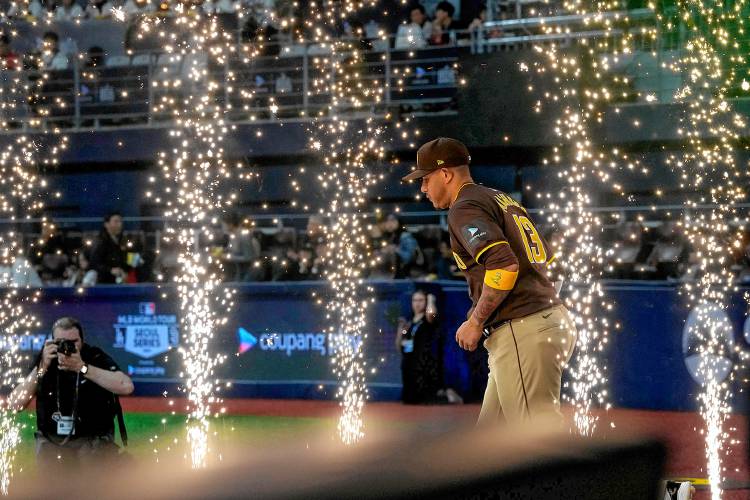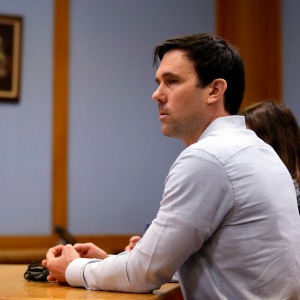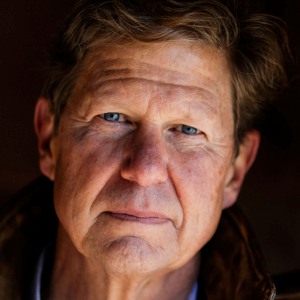Editorial: Baseball season opens amid a farewell to arms

San Diego Padres' Manny Machado takes the field as he is introduced prior to a baseball game against the Los Angeles Dodgers at the Gocheok Sky Dome in Seoul, South Korea Thursday, March 21, 2024, in Seoul, South Korea. (AP Photo/Ahn Young-joon) Ahn Young-joon—AP
|
Published: 03-22-2024 9:31 PM
Modified: 03-25-2024 12:44 PM |
With Opening Day* of the Major League Baseball season right around the corner, we sing today, as did the poet Virgil, of arms and the man — specifically the arms of pitchers and injuries to them.
First, though, let us dispose of the Boston Red Sox, as their American League East rivals will almost surely do in short order. After two consecutive last-place finishes, the Sox went into the off-season raising great expectations that newly hired Chief Baseball Officer Craig Breslow would remake the roster by signing big-name free agents while the team waits for its highly rated prospects to mature.
Great expectations proved to be a grand illusion. Breslow made a couple of trades, most notably off-loading the often injured and highly paid pitcher Chris Sale to the Braves for a promising second baseman. But instead of trying to lure free agents to Boston, ownership continues to devote its fabulous riches to its many other enterprises, all the while charging fans the highest prices in baseball. We foresee a lot of empty seats at Fenway as the season wears on.
Now about that asterisk. While Opening Day is set for Thursday when all 30 teams take the field, the Los Angeles Dodgers and the San Diego Padres actually opened the regular season with two games in Seoul, South Korea, March 20 and 21. This was part of MLB’s quest to raise the profile of the game internationally. Or at least that’s the official line. The flip side is that MLB is chasing the almighty dollar 6,000 miles across the Pacific.
The Dodgers and Padres, temporarily Seoul brothers, appeared to be enjoying themselves, but long overseas journeys at the beginning of the season often have a draining effect when the 162-game grind begins in earnest. The Dodgers committed more than a billion dollars over the winter to put together a superteam that is expected to cruise to a World Series championship. If they get off to a slow start, eyebrows will be raised about the effects of the long trip.
Baseball begins the 2024 season mostly in good shape. Rules changes instituted last year worked beautifully, shortening the time of games, bolstering offense, showcasing defense and reviving the moribund stolen base. But there is a threatening cloud: The alarming rate of serious arm injuries that are keeping many of the game’s most accomplished pitchers off the field, often for a whole season.
Pitchers were placed on the injured list 241 times in 2010, a number that rose to 552 in 2021 before decreasing slightly the past two seasons, according to The Athletic website. The number of days pitchers spent on the injury list more than doubled over a slightly longer time period.
People around baseball offer various explanations, but the consensus seems to be that the current obsession with increased speed and spin on breaking pitches is heavily implicated. The Athletic sums up: “Pitchers are throwing more breaking balls than ever before. They also are throwing harder than at any point in the sport’s history. Velocity commonly is cited as one of the biggest drivers of pitching injuries. And the sport rewards those who chase it.”
Article continues after...
Yesterday's Most Read Articles
Dr. Keith Meister, head physician for the Texas Rangers, assigns the responsibility to management. “These front offices, unfortunately, are living more in the moment than taking a longer, broader-term view,” he said. If he’s right, that would be in keeping with much of American business, which maintains a laser focus on short-term profits, often at the expense of an enterprise’s long-term health.
Parents whose children participate in youth baseball, take note. The emphasis on ever more velocity on fastballs and sharper breaking pitches is not confined to the rarefied air of the big leagues. Those who study the problem believe that many arm problems develop over time, beginning with youngsters (and coaches) who ask too much of themselves.
Once upon a time in baseball, pitching was something like real estate. It was about location, location, location — being able to thread the needle with a pitch in or just outside the strike zone. Good control married to the ability to change speeds worked wonders. And unlike now, when every pitch is thrown with maximum effort, pitchers conserved energy and their best stuff for pivotal moments in the game.
Certainly, there were always injuries, sometimes career-ending ones. But pitchers spent much more time on the mound instead of rehabbing from arm reconstruction surgery, and the fans had the pleasure of seeing them perform more regularly. If there is a broader lesson here, it is about the dangers of worshiping power when a little finesse will do.

 Editorial: Parker parole a reminder of how violence reshapes our lives
Editorial: Parker parole a reminder of how violence reshapes our lives Editorial: Chris Sununu’s moral vacuum
Editorial: Chris Sununu’s moral vacuum Editorial: Gambling tarnishes America’s sporting life
Editorial: Gambling tarnishes America’s sporting life By the Way: A white nationalist’s many mistruths
By the Way: A white nationalist’s many mistruths
